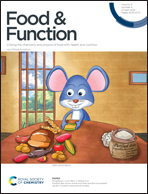Antihyperglycemic effect of an anthocyanin, cyanidin-3-O-glucoside, is achieved by regulating GLUT-1 via the Wnt/β-catenin-WISP1 signaling pathway†
Abstract
Cyanidin-3-O-glucoside (C3G), an essential representative of anthocyanins, has been proved to possess a myriad of biological activities. However, the effects of C3G on glucose metabolism and its underlying molecular mechanisms remain elusive. The aim of the present study was to investigate the metabolic impact of C3G on db/db mice and to determine whether its consequent anti-diabetic effects were related to glucose transporter-1 (GLUT-1) by in vivo and in vitro studies. As a result, through diabetic db/db mice, C3G treatment was found to significantly reduce the fasting blood glucose level and increase glycogen synthesis, which were associated with upregulation of GLUT-1 expression in the liver of the mice. In addition, in liver cells of the HepG2 and L02 lines, we further discovered that C3G could effectively promote glucose consumption by regulating the Wnt/β-catenin-WISP1 signaling pathway. Nevertheless, such effects would be restricted when the expression of GLUT-1 was blocked by the inhibitor IWR-1. Meanwhile, molecular docking technology was applied to simulate the possible action sites of C3G at the molecular level, and the results indicated that C3G might bind to β-catenin. In conclusion, our study provided evidence of the antihyperglycemic effect of C3G in vivo and in vitro via regulating GLUT-1 expression and the related signaling pathways.



 Please wait while we load your content...
Please wait while we load your content...